Every year my children's primary school organises a school trip for the whole school. It's usually based on entertainment value (eg a trip to Paleohora for the sun, sea and sand, with a taverna and cafe thrown in), but this year, thanks largely to a new headmaster, the outing took on a more educational approach. We visited Knossos, a small village located 1 kilometre away from the hospital where my daughter spent the first four weeks of her life as a premature baby, just out of Iraklio (two hours away from Hania), the largest town in Crete, or should I say, the fifth largest town in the whole of Greece.
The ominous black clouds above the school building and the few drops of rain that fell on our heads did not deter us in our excitement over the annual school trip. Greek schoolchildren lining up for assembly before boarding the buses; this village school has a small roll.
Kindergarten and 1st graders had to be accompanied by a parent or guardian, but this isn't the reason I went along on the trip. There would have to be a very good reason for me to turn down a visit to the first civilisation known to man in the whole of Europe. Knossos, headed by King Minos, existed 12 centuries before the Acropolis; the legacy left behind by Pericles does not toll as loudly as that of King Minos.

The scenery on the road from Hania to Knossos is breathtaking, to say the least. The road is coastal; above you see a wetland where the river Geropotamos in Rethimno forms a deep lake

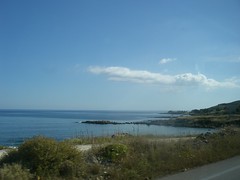
*** *** ***
Because the actual journey was a long one, we had our first pit-stop (supposedly a 10-minute toilet stop) at a coach station. This gave me just enough time to witness the horrors of the junk food culture that has overtaken the land that gave us the Mediterranean diet. Of course, you can't expect anything other than junk food and exorbitant prices in such an outlet. Most of the older children were unaccompanied and hence were given an allowance to cover such expenses, just like my children will be given some time in the future, and they will probably make junky choices like the ones the other kids made. There is little likelihood that my 'organically cooked' children will make sound food choices when they are given the opportunity to make up their own mind about what to buy from such refreshment kiosks.
The coach station was a good opportunity to watch how some parents try to kill their children. The (obese) mother in the right is helping her (fat) child to have just enough fizzy drink to make him feel queasy when he gets back on the bus (and vomit along the windy road to Iraklio, I suppose), while his (fat) brother ponders over how he will manage to eat his way through a whole chocolate bar, a large ham and cheese sandwich and a fizzy drink before he gets back on the bus; the driver specifically stated: "No eating or drinking except water."
Needless to say, I bought along some home-made cake and two bottles of water. We sat communally with other parents and children, watching them all devouring crap. My daughter threw a tantrum. "Cake, cake, always cake, can't we just buy something?" She began to cry in that way that children do, when they think there is some hope that their parents will become embarrassed and then succumb to their whims and fancies.
Life sucks when your mother's in charge.
We had all had a decent breakfast before leaving the house. The bus was air-conditioned, and we were seated for over two hours. How much energy does one expend under such conditions? And where the hell is the Mediterranean diet anyway, and the traditional Greek mother who'd spent the previous night cooking up a whole picnic to feed an army?
*** *** ***
The last stretch to Iraklio (Knossos lies 3 kilometres out of the centre of the town) is on a curvy hilly road. It isn't the most scenic route, but you get an idea of how different Iraklio is to Hania, and how unlike an island Crete actually is. Iraklio is overpopulated for the surface area it covers. It is bordered by the sea in the north, while high mountains border the prerimeter of the city to the south. Apartment blocks have even been built in the midst of mountain forests (possibly not legally); Iraklio lacks residential space. Despite its random building projects which give it a haphazard Athenian neighbourhood look with tall aesthetically-lacking apartment blocks, Iraklio is an important centre in Crete and has a lot of clout politically and economically.
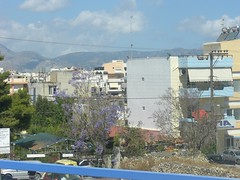

As you enter or drive through Iraklio, you can't help wondering if you've lost your way and gone to Athens instead; it lacks any of the charms associated with a Greek island.
Hania may be a more beautiful part of the island, but Iraklio is more organised, more judicious and more hard-working than the other prefectures of Crete (personal experience). There is a certain amount of friendly rivlary felt between the Haniotes and the Irakliotes, and not without reason (Hania lost its capital city status to Iraklio in 1971), but Iraklio is still the city and prefecture that attracts people from all over the country, being located right in the middle of the northern coastline of the island. It's been the largest urban centre in Crete since Minoan times.
If you know what there is to see, you will look out for Mount Youktas, where the leader of the Greek gods is buried (you can see his face in the outline of the moutain). Zeus was a Cretan, born either in or in Dikteon Andron in the Lassithi plateau, who ruled in Mount Olympus, and died in Crete, despite being immortal.
After a 2 1/2 hour bus trip, we found ourselves outside Knossos at the commercial part of the site, where the cafes and souvenir shops are located.
Parents were given a choice of accompanying their children for half the price of the full 6-euro ticket (children on school trips enter for free with their teachers), or wait outside the entrance to the site until the children finished the (guided!) tour. It is embarrassing to confess that most of them preferred to remain as educated as they were before they left their homes that day ("I came here on a school trip when I was a kid, I've already seen this before!").
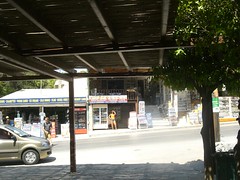
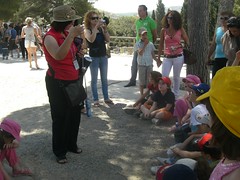
Some parents headed off to the nearest cafe; I picked up the official guidebook from the site (6 euro, available in many foreign languages). The souvenirs are good value if you are into ornamental reproductions. Our mellifluous guide carried a blue umbrella high above her head as we walked with her; our school was not the only visiting Knossos on that day!
They decided not to enter the site (which would have cost them only 3 euro); they probably amused themselves instead by hanging out at the cafe bars that were dotted around the area, drinking frappe coffee, eating more junk food, and buying some more sugary drinks for their kids just before they began their tour (the teachers kept reminding them that they were on a no-food-allowed site).
With our water, hats, sunscreen and sunglasses (Knossos is very exposed to the burning sun), we entered the ruins of the palace of Knossos, which itself is surrounded by the remains of the houses of Minos’ subjects, who lived outside and around the palace grounds, which is why taking just one little step in the area means that you are walking on some more of the hidden ancient antiquities that the world is simply waiting to be brought to light...
*** *** ***
The earliest evidence of human activity in Crete comes from 6100 BC, in what is known as the Pre-Pottery period. No findings from the Paleolithic age (paleo - old; lithic - stone; the Old Stone Age) have been determined yet in Crete (although they exist in other parts of Greece), but this could happen in the future; the Paleolithic Y-haplogroup heritage predominates in the gene pool, as found in a Cretan highland plateau. Remains of wheat, barley and lentils, as well as the bones of domesticated animals (goats, sheep and pigs) indicate that this group of people were not nomadic. Between 5700-2800 BC during the Neolithic Age (neo - new; lithic - stone), people were living both in both caves and houses constructed of rough clay bricks, stone and wood . The population of Crete at this time was composed of different nationalities, most likely from the west rather than the east Mediterranean.For many years, the palace at Knossos remained under the ground, most likely due to a volcanic eruption in Santorini, which created such a large tsunami that it covered the coastal areas of
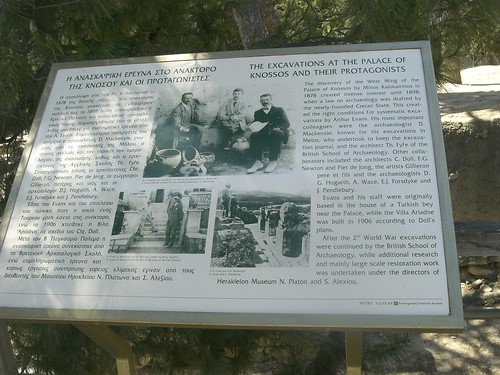
Sir Arthur Evans unearthed most of the treasures in Knossos, but it was actually a Cretan (Minos Kalokairinos) who first dug up a part of the palace.
... but the Ottoman (Turkish) rulers of
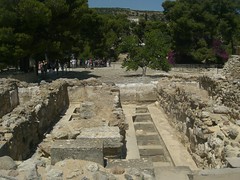

In 1878, Minos Kalokairinos discovered part of this storage area for the pithoi (urns) which held olive oil and wine. Unfortunately, due to the flammability of the oil, this is where a fire broke out and destroyed the palace in the 14th century BC.
In 1900, mainly due to luck, just a few years after the Ottomans were ousted from their official ruling role in Crete, the site of Knossos fell in the hands of the kindly Englishman Arthur Evans, who the town of Iraklio now thanks for helping unearth the treasures of Knossos with a well-deserved statue of Sir Arthur at the entrance of the ancient site. He excavated most of what we see nowadays of
*** *** ***
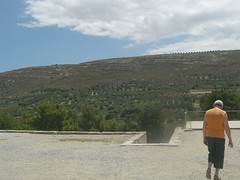
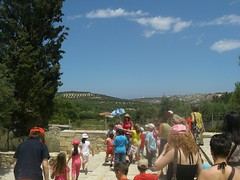
The Minoans were surrounded by beautiful scenery - low undulating hills, the bright green foliage of the trees and the clear blue sky.
This tour was intended for the lower primary school grades, which made those stories sound even more thrilling; the adults simply have to read between the lines as they hear about the antics of the Greek gods to turn this amazing story into one of sexual fantasy and intrigue:
"One day, Zeus spotted Europe as she was playing in the fields, and he thought she was the most beautiful girl among all her frolicking friends. So he transformed himself into a gentle bull and lured her away from her native land, taking her to the shores of
She had three children with him, one of which was Minos, who became a King and married Pasiphae; the
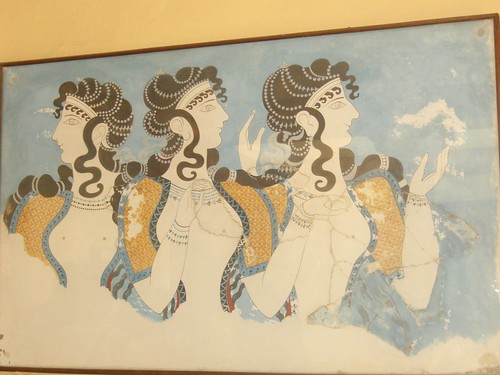
The reconstructed frescoes give us an idea of what the Minoans looked like 3000 years ago: they were short (in our terms), with a tanned skin, dark eyes and dark hair. Males (always depicted in red) and females (always painted white) had similar hairstyles and clothing. The symbol of the bull features throughout their culture: the birth of King Minos, the Minotaur, and the Bull Games (Ταυροκαθάψια - tavrokathapsia).
Minos was such a powerful king that when Aegeus, king of Athens, killed Minos' son Androgeus, Minos had the Athenians send him the 7 most handsome boys and the 7 most beautiful girls from the mainland, whom he threw into the darkness of his labyrinthian palace which had many rooms and was difficult to get out of once you got in. These young people got lost in the maze, where they were eventually eaten up by the hungry Minotaur, a half-bull half-human creature (the creation of Minos' wife Pasiphae, after she had an affair with - you guessed it - a bull) who lived in the centre of the labyrinth.
The Minotaur was eventually killed off by one of those young people, Theseus, who was also able to find his way out of the palace with the help of Minos' daughter Ariadne, who gave him a ball of string which he tied to the entrance of the labyrinth that showed him the way out as he twined it back into a ball.
"Minos was a bit more than a tad angry when he realised what had happened, especially since Ariadne took off with Theseus to

Undoubtedly, these images are the most famous from Knossos, known all over the world: top - the Queen's room; left - a reconstruction of part of the palace; right - the throne room; bottom - close up of the reconstruction.
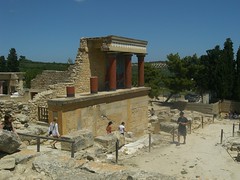
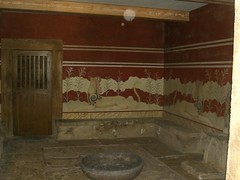
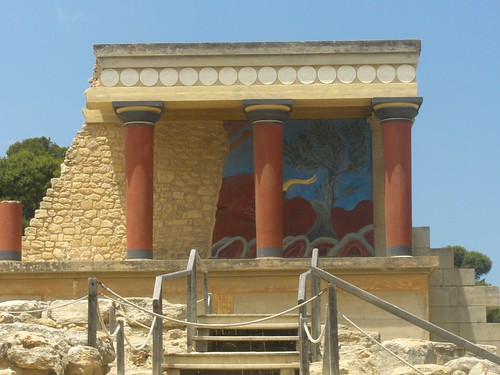
Minos knew that Ariadne must have got help from someone cleverer than herself, so as to be able to help Theseus; he laid the blame on the designer of the palace, Daidalus, who realised that if he wanted to escape the palace and Minos' scrutiny, he would have to find a route other than by land or sea, as Minos controlled these two pathways. He chose to fly out with his son, Icarus, with the help of a set of wings he made for each of them using bird feathers that fell in the palace grounds and beeswax.

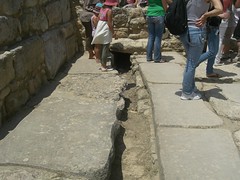
The Minoan civilisation is the first known literate civilisation in Europe. The Minoans were very advanced for their times: they had invented intricate sewerage systems that even included flushing toilets. This amphitheatre pre-dates Hellenistic ones: they were square and people always stood up. Maybe the local council convened here and discussed things like smelly sewerage... Interestingly, no weapons have been found at the site, which leads one to believe that the Minoans were a peaceful race, but this also left them vulnerable to attacks.
He warned Icarus not to fly too close to the sun, because the wax would melt and the feathers would come loose, and he'd lose his wings and fall to his death. But Icarus did what all children even in modern times do - he disobeyed his father, flew too close to the sun, and eventually lost his wings. The sea where he fell was named after him (Ikarios), from which the name of the nearby island is also derived (
"His father survived and ended up in
And that was the end of King Minos, but not his splendid palace and the civilisation that he created. The Minoan civilization became vulnerable to attacks by mainland Greeks after 1450 BC, which was approximately the time of a volcanic eruption in Santorini that created a tidal wave that reached Crete and possibl covered Knossos with ash. The Minoans were conquered by the Mycenaeans who gave Crete the many Peloponesian-sounding placenames that are still in use today, but after the fall of
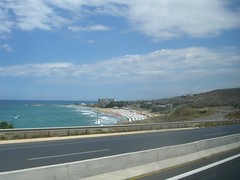

Crete's two main export products: tourism and agricultural products, mainly olive oil, usually found side-by-side all over the island.
That's when Crete started to take on a Greek look; the Eteocretans (the real Cretans, as Homer called the original Cretans before the invasion of conquerors) eventually turned into Greeks, so that, by the ninth century BC,
*** *** ***
After the guided tour which lasted 1 1/2 hours, we left the palace grounds, and entered the fast modern world that we had left behind just before we started our journey. We were all a little thirsty, so I looked round the commercial part of the
I ordered two cups of freshly squeezed orange juice, and nearly fainted when I heard the price: 4 euro a cup. I felt relieved that we haven’t been selling our orange crops for the last two years (due to the low prices offered to producers of agricultural products and the difficulty of finding a wholesaler willing to organize the labour), because Iraklio imports from our region – it is not an orange-producing area; Iraklio is known for its olive oil and grape wine. At least I wasn’t paying to drink my own product (although it was absolutely delicious and perfectly refreshing).

My kids ate all the chips but left the souvlaki; I couldn't blame them. I succumbed to letting them have one ice-cream for the day.

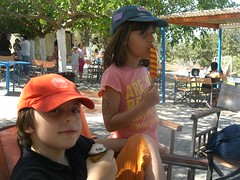
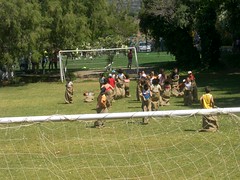
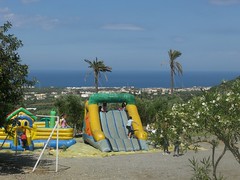
At least they were kept active before and after the meal. Hersonissos is in the distance, a few kilometres out of Iraklio city.
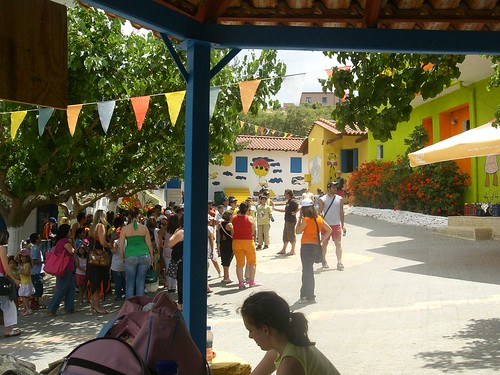
None of the children chose the healthier option of youvetsi which was cooked to perfection and very tasty. Ice-creams and fizzy drinks were provided at a cost, and there’s no need to tell you that everyone (except us) was downing them by the dozen. What the Eteocretans or the Minoans would have thought of us if they were watching us at that moment remains a mystery. A year ago, I was bragging, boasting and pumping my head off that the Mediterranean diet is alive and well and living in my children's school; a year on, it seems that it's almost dead and buried, living only as a fading memory.
This post is dedicated to Laurene, who knows more than I do about Knossos.
©All Rights Reserved/Organically cooked. No part of this blog may be reproduced and/or copied by any means without prior consent from Maria Verivaki.

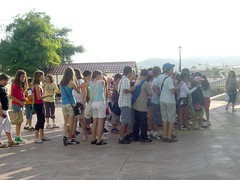
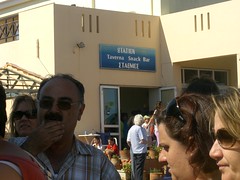
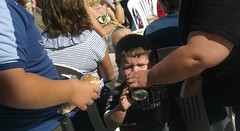
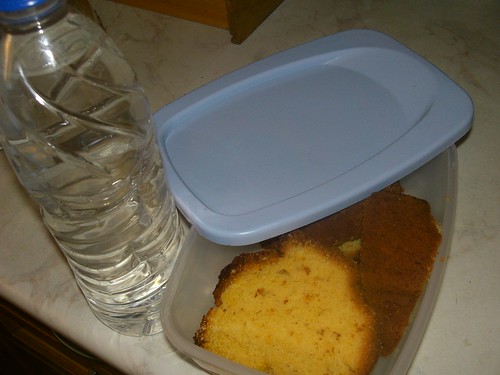


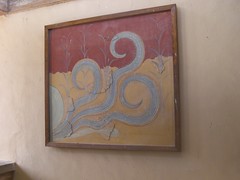
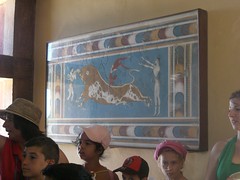
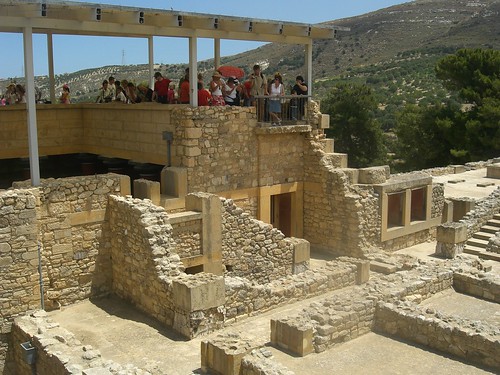
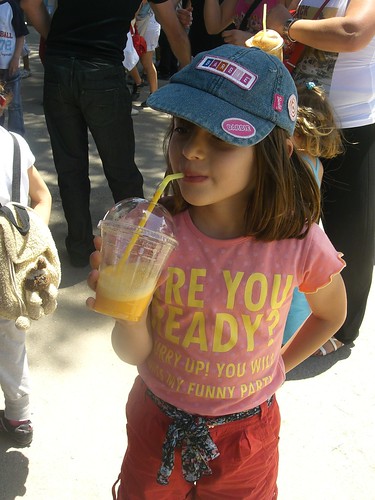
Thank you for this beautiful, educative trip to Knossos!
ReplyDeleteI applaud your healthy choice of food. Once again, it amazes me what's happened to the Mediterranean diet in the last decades - having seen the same "phenomenon" occurring in Spain as well.
Thank you for dedicating this wonderful account of your visit to Knossos to me! I enjoyed it immensely, especially your extensive knowledge of the site & of Greek mythology. I felt that I, too, walked with you around those ruins which I have come to know & love only through the art history books that I have read over my lifetime. I probably will never get the chance to physically visit Knossos, but you have helped me to make the journey today, nevertheless.
ReplyDeleteSomething you wrote resonated with me strongly: "...taking just one little step in the area means that you are walking on some more of the hidden ancient antiquities that the world is simply waiting to be brought to light..." This is the real challenge of archaeology: not to resurrect the palatial splendors of ancient royals, but to make a real connection to the lives of the common men & women who lived in those times & made their livings by supplying the materials, labor and service to the rich. This is the direction archaelogists are most interested in today.
I see much of Europe as just a spade-ful of earth away from a new & exciting discovery. And this is what sparks my enthusiasm for ancient cultures.
Again, thank you so much.
Once again, your post has brought back so many memories - some happy, some not so....
ReplyDeleteI agree, the diet that younger Greeks have adopted - because they now have the money - is killing them. We see the same thing happening here. Levels of obesity are sky-rocketing. Some of it is the crappy food they have access to but some of it is the amount of stress they are having to cope with. It ain't pretty.
Thanks for the tour of this piece of world history. Still hoping to make it to Crete some day. A friend of mine does walking/hiking tours there.
ReplyDeleteA change for the better with that new headmaster :-D
ReplyDeleteI was thrilled when i visited the place for the first time...It is definitely false economy not to enter this space even at the full ticket price. Sure, many things can be said for mishandling of money but let's be typical. There are people who work to keep these spaces clean and prohibit damage (which you can't think where it could come from :-/ People wanting to carve their names on monuments, piss everywhere....sad, really). The ticket price is supposed to work towards preserving the place.
The posters i got from there were really nice, reminding me of my school years :-D
(Life sucks indeed when "your mother's in charge" :-D :-D :-D)
4€ for a cup of orange juice? Was it freshly squeezed by some royal figure or what? I dare say that this seems like a high price even for the UK which does not have a huge production in oranges (i am not saying, "not production at all" because i have been to an "orangery" near by where orange trees are on big pots on wheels and are reeled out in the Sunshine (whenever we get it) and then reeled back in again when there's rain........I was astonished :-/ )
We visited Knossos when we were on Crete about 13 years ago. I still remember how impressed I was! It is a remarkable structure. Unbelievable that it is soooo old.
ReplyDeleteCrete is still as beautiful as I remember:)
We will have to make it to Chania some day!!
wonderful post and lessons!well done!
ReplyDeleteI love this post!
ReplyDeleteVery informative and also hilarious...
Your poor, poor children...all that they had was homemade cake!:)
I still can't believe that parents would actually travel that far with their children and NOT go into the site with them! Blows my mind.
Great post Maria, Knossos looks amazing. Hopefully one day I'll take my children.
I commented yesterday but I can't see it anywhere! Anyway, I just wanted to say that I enjoyed the post and found it very informative and educational. Also, very interesting to note the junk food culture gripping Greece. At least you know you payed 4 Euro for something good and fresh.
ReplyDeletei know i got good wholesome food for that high price, but i cant get over how this orange juice was being sold for such a high price - it had only travelled less than 200km over land. the upmarketness of that cafe, plus its location, makes me think that it was operating with a high rent, and this was the easiest way to pay it!
ReplyDeletegreat post! Poor kids - have to eat home-made cake!:-) unbelievable how many parents feed their children garbage and then don't even accompany them on the tour. your kids will appreciate you!
ReplyDeleteYeah, I finally was able to access your blog! I keep trying, but my system hangs and hangs and hangs! I'm paranoid I'm going to lose the connection, so I'll make this quick! Plus, don't think I've stopped visiting! Hopefully my system will calm down soon. ANYWAY ... LOVE this post! Gosh, what an amazing field trip ... I felt like I was right there with you! The pictures are awesome, and I'm just amazed at the rich history therein. LOVE this post! :-)
ReplyDeleteI adore that mosaic with the dolphins! Just keep on posting Cretan postcards...you're cementing a visit to Crete in 2010.
ReplyDeleteThank you. I enjoyed my (your!) trip to Knossos. I really liked the Dolfin mosaic, too. Also liked your view of the mountain from the bus, and your commentary about the junk food!
ReplyDeleteThe picture of the three sons was very fun & festive (why do we always think they were so serious in the past?!)probably a reflection of the people.
I learned so much with this post and felt I was on an actual vacation in Crete!
ReplyDeleteYour pictures are so beautiful, Maria- you live in a fabulous part of the world.
I've had trouble accessing your blog lately, along with a number of others- I haven't quit reading, just having trouble with blogger.
Wonderful post. Having been to Crete 4 times, I have yet to see the Knossos...I know, I know...shame on me. Next time.
ReplyDeleteThe drive along the E75 to Iraklio has some lovely scenery. It always means we are going on holiday or heading to the airport to come home.-sigh-
First of all, Maria, please tell us how you REALLY feel about junk food and the parents who feed it to their kids! 8-D
ReplyDeleteI can't tell you how much I enjoyed this post! I can not believe that anyone would refuse any opportunity to walk in the midst of incredible history. The officials at Knossos would have to keep an eye out for me because I would not want to leave! You are so right about our disposable modern world; I lived in Charlotte, NC which was established in the mid-18th century, one of the country's earliest settlements, and yet there are virtually no buildings standing from before late 19th century! Instead, there are little bronze markers telling us what used to be there. Not quite the same thing.
My dream is to visit such sites as Knossos, Herculaneum/Pompeii, Machu Picchu, etc. - I do not want to contribute to their physical degradation but I long to walk in the footsteps of the ancients. One of the most remarkable aspects of the Minoan civilization is that, unlike many early civilizations, very few weapons were found and no other signs of militarization such as walled fortifications. It is so true that there are valuable lessons in history if only we're willing to learn . . . !
Unfortunately, as you said the healthy Mediterranean diet is fading away. I also notice it when I visit Turkey. There is a more tendency towards junk food. Some mothers think that, they are doing a favor for their kids by buying them junk food. Or some of them just don't want to deal with making any homemade snacks or cakes like you did for your child.
ReplyDeleteKnossos sounds like a very interesting historical site. I have heard of it but didn't know this much about it.